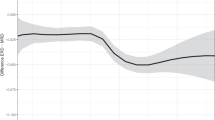Abstract
Background
Extremely low birth weight (ELBW <1000 g) infants may have increased sensitivity to radiation exposure. Our objective was to estimate the radiation exposure in survivors of ELBW infants during their neonatal intensive care unit (NICU) stay.
Methods
In this retrospective cohort study, medical records of all ELBW infants who had been admitted to our NICU between May 1999 and October 2009 were reviewed. The infants’ total entrance skin exposure [ESE in micro-Gray (μGy)] was estimated.
Results
Among 450 survivors, the mean gestational age (GA) was 26.3±2.1 weeks, and the mean birth weight (BW) was 774.2±144.4 g. Infants received a median of 32 (range: 1–159) X-rays, with an estimated ESE of 1471 μGy (range: 28–9264). Total ESE was inversely proportional to GA (r=−0.34; P<0.01), and BW (r=−0.39; P=0.01) and proportional to the severity of illness [score for neonatal acute physiology-perinatal extension (SNAPPE), r=0.39; P=0.01]. In a linear regression analysis, GA, SNAPPE and necrotizing enterocolitis were associated with radiation exposure (ESE) in ELBW infants (r2=0.133; P<0.001).
Conclusions
During their NICU stay, ELBW infants were subjected to a significant number of diagnostic X-ray procedures. Our data highlight the need to closely monitor the number of X-ray procedures ordered to ELBW infants to avoid unnecessary radiation exposure.
Similar content being viewed by others
References
Hall P, Adami HO, Trichopoulos D, Pedersen NL, Lagiou P, Ekbom A, et al. Effect of low doses of ionising radiation in infancy on cognitive function in adulthood: Swedish population based cohort study. BMJ 2004;328:19.
Sasaki S. Age-dependence of susceptibility to carcinogenesis by ionizing radiation in mice. Radiat Environ Biophys 1991;30:205–207.
Sasaki S. Influence of the age of mice at exposure to radiation on life-shortening and carcinogenesis. J Radiat Res 1991;32Suppl 2:73–85.
Streffer C, Shore R, Konermann G, Meadows A, Uma Devi P, Preston Withers J, et al. Biological effects after prenatal irradiation (embryo and fetus). A report of the International Commission on Radiological Protection. Ann ICRP 2003;33:5–206.
Puch-Kapst K, Juran R, Stoever B, Wauer RR. Radiation exposure in 212 very low and extremely low birth weight infants. Pediatrics 2009;124:1556–1564.
Donadieu J, Zeghnoun A, Roudier C, Maccia C, Pirard P, André C, et al. Cumulative effective doses delivered by radiographs to preterm infants in a neonatal intensive care unit. Pediatrics 2006;117:882–888.
Smans K, Tapiovaara M, Cannie M, Struelens L, Vanhavere F, Smet M, et al. Calculation of organ doses in x-ray examinations of premature babies. Med Phys 2008;35:556–568.
Ono K, Akahane K, Aota T, Hada M, Takano Y, Kai M, et al. Neonatal doses from X ray examinations by birth weight in a neonatal intensive care unit. Radiat Prot Dosimetry 2003;103:155–162.
Wilson-Costello D, Rao PS, Morrison S, Hack M. Radiation exposure from diagnostic radiographs in extremely low birth weight infants. Pediatrics 1996;97:369–374.
Brenner D, Huda W. Effective dose: a useful concept in diagnostic radiology. Radiat Prot Dosimetry 2008;128:503–508.
The 2007 Recommendations of the International Commission on Radiological Protection. ICRP publication 103. Ann ICRP 2007;37:9–34.
Council Directive 97/43 Eurotom of 30 June 1997 on health protection of individuals against the dangers of ionizing radiation in relation to medical exposure, and repealing Directive 84/466/Eurotom. Official Journal L 180, 1997: 0022–0027.
Radiological protection and safety in medicine. A report of the International Commission on Radiological Protection. Ann ICRP 1996;26:1–47.
Center for Drug Evaluation and Research UFaDA. White Paper: Initiative to Reduce Unnecessary Radiation Exposure from Medical Imaging. Center for Drug Evaluation and Research, US Food and Drug Administration, 2010. http://www.fda.gov/Radiation-EmittingProducts/RadiationSafety/RadiationDoseReduction/ucm199994.htm (accessed December 19, 2011).
Radiation risks of diagnostic imaging. The Joint Commission. Sentinel Event Alert 2011; (4):1–4.
Bar Joseph N, Reisfeld D, Tirosh E, Silman Z, Rennert G. Neurobehavioral and cognitive performances of children exposed to low-dose radiation in the Chernobyl accident: the Israeli Chernobyl Health Effects Study. Am J Epidemiol 2004;160:453–459.
NRC. Health risks from exposure to low levels of ionizing radiation: BEIR VII-Phase 2. National Research Council. Washington D.C: The National Academies Press, 2006: 281.
Author information
Authors and Affiliations
Corresponding author
Rights and permissions
About this article
Cite this article
Iyer, N.P., Baumann, A., Rzeszotarski, M.S. et al. Radiation exposure in extremely low birth weight infants during their neonatal intensive care unit stay. World J Pediatr 9, 175–178 (2013). https://doi.org/10.1007/s12519-013-0417-1
Received:
Accepted:
Published:
Issue Date:
DOI: https://doi.org/10.1007/s12519-013-0417-1




